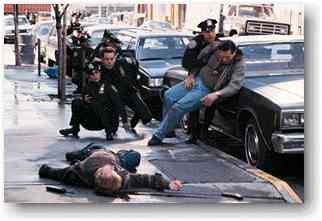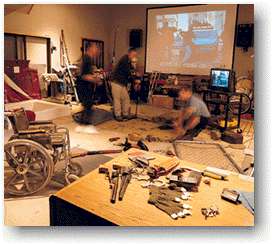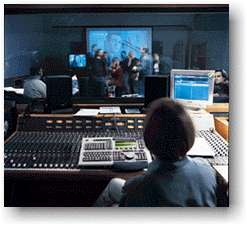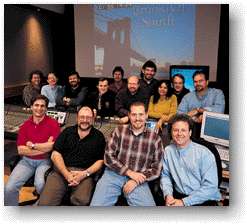|
"Act
#4 is gonna be a bitch!"
Sound Editorial for "Brooklyn
South"
at Miles O' Fun and Westwind Media
Written in February 2004 by
Mel Lambert
The visitor has wandered, unknowingly, onto the set of "Brooklyn South," a
highly realistic reproduction of New York's 74th Precinct House built on CBS
Studios Radford Lot in Studio City, CA. Fortunately, the cast and crew are
between takes. Catching the eye of a production assistant, he is directed to the
building's second floor, where the show's co-producer, supervising sound editor
and others are meeting tonight with the picture editor. Their immediate agenda:
to view a final cut of Episode #10, and spot the hour-long drama for sound
effects, Foley, looped lines and the other myriad sonic detailing that's
necessary to produce a high-impact TV drama like Steven Bochco Productions'
"Brooklyn South."
 Still
fighting off the effects of a bad head cold, picture editor Scott Eilers' first
comments are blunt: "Act #4 is gonna be a bitch!" Indeed, Act #4 of
this particular episode culminates in a violent bank heist that goes horribly
wrong. It centers around one of the primary characters saving the life of
his brother, an undercover cop posing as a member of the robbery gang. Directed
by Michael Watkins, it's a fast-action, tightly-edited sequence, requiring a
large amount of looping, Foley, hard effects and some focused attention to
dialog editing. A walk in the park as it turns out for the sound editorial and
mixing team from Miles O' Fun Sound and Westwind Media. Still
fighting off the effects of a bad head cold, picture editor Scott Eilers' first
comments are blunt: "Act #4 is gonna be a bitch!" Indeed, Act #4 of
this particular episode culminates in a violent bank heist that goes horribly
wrong. It centers around one of the primary characters saving the life of
his brother, an undercover cop posing as a member of the robbery gang. Directed
by Michael Watkins, it's a fast-action, tightly-edited sequence, requiring a
large amount of looping, Foley, hard effects and some focused attention to
dialog editing. A walk in the park as it turns out for the sound editorial and
mixing team from Miles O' Fun Sound and Westwind Media.
Starting
from the act-up and opening titles, and proceeding through the demanding
eight-minute montage that is Act #4, Eilers runs the picture for the assembled
crew. As he stops and starts the playback from his Avid Media Composer
workstation, Eilers explains what he considers to be key aspects of the drama,
and where certain sounds might be required. All we hear is the roughly edited
production track, plus some temp music and effects that Eilers has laid onto the
reel. As a former sound editor on such shows as "In the Heat of the
Night," and HBO's "Heart of Darkness," Eilers has a
well-developed sense of where sonic treatments can add to the drama he's been
cutting. "That background helps me to cut more freely," Eilers
considers, "knowing that there are ways to cover certain transitions with
sound. Because I know what can be fixed in post, I'm free to concentrate on
making the pictures work together, without worrying too much about outside
details."
Overseeing
the sound editorial and mixing of this season's "Brooklyn South" is
Supervising Sound Editor Victor Iorillo, from Miles O' Fun Sound, a full-service
editorial facility located within Westwind Media's Burbank headquarters. Also
located in this recently opened complex are Scoring, Music Editing, Foley and
ADR Stages, plus a pair of identical Dubbing Stages, one of which is used to mix
"Brooklyn South."
Despite his wide range of experience in
supervising and editing sound for film and TV (including the much-admired "My So
Called Life"), "Brooklyn South" marks Iorillo's first time as sound supervisor
for a prime-time show. "And this episode of 'Brooklyn South,' was a logistical
nightmare," he recalls of the week-long process from edited workprint to turn
over to the network. "We normally have five days for editorial, two days for the
mix, and maybe half a day for fixes after the show has been viewed by [Executive
Producers] Steven Bochco, William Finkelstein, David Milch and their staff."
Spotting
Session
During
the spotting session, Iorillo is looking closely for lines that will need to be
looped, general hard effects to be pulled from the library or recorded
specifically for an episode, plus Foley and other elements. "On a busy show
like this," he offers, "I'm continuously making notes! I want to make
sure that we all feel happy with how we are going to envelope the show, and what
will be needed during the dub. I don't want there to be any surprises!
|
 |
|
Foley recording for " Brooklyn South" with
Foley artists Zane Bruce and Dale Perr
|
"I
could tell from the run through that Act #4 - the Bank Heist - was gonna be real
challenging." It turns out that Act #4 had been pretty much unscripted; the
director developed a basic framework for the action, but experimented with
the cast once they reached the set. The scenes were shot three times, using
different camera angles.
"We
had a lot of lines that needed to be replaced," Iorillo stresses, "and
a lot of group ADR for the bank customers - shouts and cries and they were being
threatened by the three robbers. We also had a lot of Foley to cover, plus hard
effects. We also knew that there was going to be music playing throughout the
scene, and so our detailing was more important than ever, to hold the
attention."
Because
of the high degree of sonic detailing that goes into each episode of
"Brooklyn South," Iorillo normally assigned two Effects Editors, an
ADR Editor plus four Dialog Editors to work in parallel on each episode. Editing
of Mike Post's score is handled by Westwind Media. "Even with access to
this many [editorial] people," Iorillo states, "we are under the gun
to meet the mix date."
Overall "Sonic
Texture"
In
terms of establishing an overall "sonic texture" for the show, Iorillo
says that obvious models were "NYPD Blue" and "Hill Street
Blues," two of Bochco's previous cop dramas. "But we needed to
establish a unique feel to the show, and one that could be a consistent factor
from show to show." The decision was made, he recalls, "to maintain
more of an 'internal' or 'intimate' atmosphere to the station house, rather that
use a lot of external traffic sounds, as is the case with 'NYPD Blue,' which we
edited at Mile O' Fun.
"Also,
we established a unique sound for each of the rooms on the set - even recording
room tone from the largest entrance lobby/squad room - and making the upper
rooms more quiet that the lower ones; the interview room, for example, is
considered to be one of the quietest rooms in the precinct house. Having
established that 'protocol,' so to speak, we know what ambiances and backgrounds
to build for each of the scenes once I have spotted [the show]. We also use
sound textures to establish the time of day."
Once
an episode has been turned over to the editorial crew, under Iorillo's
direction, effects tracks can be quickly roughed in with a number of
backgrounds. "We make extensive use of Fairlight MFX3-Plus systems here at
Miles O' Fun," the supervising sound editor continues, "and can call
up general sounds we know we will need for each episode - doors opening and
closing, typewriters, street sounds and the rest - from our effects libraries.
And since Foley and [principal plus group] ADR is recorded directly to Fairlight
hard drives, we have consistency between all of our recording and editing areas.
And we also have DaDs [Fairlight Digital Audio Dubbers] for playback on the
re-recording stage, which helps speed up the dub when we make changes."
"The
MFX3 is perfect for dialog editing," says David Beadle, who was added to
the editorial crew to handle the complex dialog cutting chores on Act #4.
"I can lay up the source reels against timecode very quickly, phase them to
check sync, and then split them off [onto separate virtual disk tracks] as we
build the reels. Making edits and trimming in/out points is real fast, using
handles and dedicated nudge keys on the [MFX3 control keyboard], while assigning
variable crossfades."
Effects
Editing
In
terms of effects tracks, Victor Iorillo continues "There are a lot of
sounds we need that are unique to the location: the elevated train, sirens and
cars we use to place the viewer into the action. For the bank heist, we also
needed helicopters, traffic noises, weapon noises, floor skids, door scrapes,
tire squeals, and so on. I knew during the spotting session that, because it was
so complex, we would need a extra day to cut the effects on this one
scene."
Principal
effects editor on "Brooklyn South," is Rick Hromadka, working with
Steve Sax. "I use the 24-track [MFX3-Plus] to prepare 12 mono effects
tracks, plus six stereo tracks across #13 thru #24." Stereo tracks include
police-sound backgrounds, traffic wash, and traffic drones. "There is never
silence in a scene," Hromadka offers. "We always have something
playing out. And sound is often used as a punctuation, such as a siren at the
end of a scene to denote a transition. And to establish the fact that we will
see rain at the end of Act #4 - they shot the exteriors over two days; day #1
was dry, and then it suddenly rained - I used a touch of thunder as a subliminal
cue so that the audience would accept the fact that now it was raining."
Foley
was recorded on Westwind's Stage #4, directly to an eight track MFX3 system:
mono footsteps across tracks 1 thru 4; props across 5 thru 7; and movements to
track #8. "We record all of the cloth and movements in the first
pass," Iorillo offers, "followed by all of the feet sounds, with
different shoes and surfaces. Then we do the props." Working with seasoned
Foley artists Zane Bruce and Dale Perry, it takes around 10 hours to cover Foley
for an hour-long drama like "Brooklyn South." "But, for the bank
heist, we had a lot more clothing, shoes, weapons and other elements to cover,
so we ended up going into overtime!"
ADR
was recorded over a period of two days: principal ADR on the first day, and
group on the second. At the Trident Series 85 console in Westwind's Stage #5
were engineer Stacey Michaels and recordist Stephen Fit Maurice. "For the
group ADR we use a great bunch of actors. Superpowers work on many of our
shows, and know the type of elements we're looking for. Also [co-producer]
Joseph [Berger-Davis] works in the room with the actors, and oversees the
process of developing realistic lines for the backgrounds, wallabies and the
rest."
|
 |
|
ADR
Recording with Superpowers to prepare
ensemble backgrounds for
bank-heist scene
|
The
actors are pretty much left to develop lines themselves - either as singles or
doubles - producing impromptu dialog as they walk across the stage in front of
the mice: "I saw him over at the two-seven, and he's gonna take care of
it" - such lines were laid under principal actors in scenes shot in a
crowded squad room, for example, or when an actor might be speaking in the
street. Superpowers also recorded a series of ensemble backgrounds for the
bank-heist scene, including a series of realistic-sounding screams, whimpers and
cries. "The dynamic for group ADR is for the actors to react to the
picture," Iorillo says, "They respond to the ups and downs of the
action, and the general 'feel' of a scene."
The
Mix
With
the various dialog, effects, ADR and Foley elements edited in sync to MFX3 hard
drives, and then transferred to Dad format for playback, the project moved onto
Westwind Media's Stage #1, where mixers Elmo Ponsdomenech (dialog/music) and
Craig Otter (effects) prepared the Euphonix CS-3000 console for the dub session.
Due to its complexity, Act #4 was allocated a compete day for mixing.
"Music arrives [from composer Mike Post] as four stereo pairs," Elmo Ponsdomenech
recalls, and is laid up to a 24-track Dad with Foley. "Dialog
was on a single Dad: eight tracks of principal production dialog, eight of
principal ADR, and eight of group Walla. And we had 24 tracks of effects on Dad."
Doremi V1 random-access video drives are used on Westwind's dub stages to
dramatically reduce access time.
"Our
biggest challenge," Craig Otter considers, "is to get the mix competed
in the time we have available. With a complex real like Act #4, we can take
advantage of the CS-3000's automation to save us a lot of time, but it still
becomes a clock crunchier!"
In
terms of a dramatic conclusion, Act #4 has been heading towards the inevitable:
the shooting of one of the perpetrators by Police Officer Jimmy Doyle (Dylan
Walsh) to save his brother Terry (Patrick McGraw), posing as an undercover cop.
"After eight minutes of dramatic music and high drama," Iorillo
reflects, "we were not sure how to underscore the actual shooting. There
were initial suggestions during the dub that we hold silence just before Officer
Doyle aims and shots the bank robber, who is drawing a bead on Terry Doyle.
"I
had also cut a sequence using some unusual organic electronic effects and a lot
of processing that we tried under the music. In the end, we experimented with it
a couple of ways, and" - after a trial showing at Steven Bochco Productions
- "we went with no music at the climax. I think making space for the
audience to fill in its own emotional conclusions at that point - rather than
having the high-power score and effects heighten the mood - worked very
well."
"Yes,
Act #4 of that episode of 'Brooklyn South' posed some unique challenges,"
supervising sound editor Victor Iorillo concludes. "But with the manpower
resources we have available at Miles O' Fun and Westwind - plus some
cutting-edge workstations - we love to respond to whatever is thrown at us. A
show like 'Brooklyn South' depends on good sound to complement the great visuals
and outstanding acting."
|
Editorial
Crew for "Brooklyn South" at Miles O' Fun
Clockwise from front right: Craig Otte, re-recording mixer; Joseph
Beregr-Davis, co-producer; Victor Iorillo, supervising sound
editor; Elmo Ponsdomenech, re-recording mixer.
Back row (L to R): Fred
Clemons, recordist; Peter Fausone, technical director (Westwind
Media); Nino Centurion, music editor; Todd Langner, chief
engineer; David Beadle, dialog/ADR editor; Rick Hromadka,
sound FX editor; Larry Goeb, dialog/ADR editor; Steve Sax,
sound FX editor; Sonja Henry, dialog editor; Russ deWolf,
dialog editor; Tom Scurry, dialog/ADR editor |
 |
Facility photographs
©2026
Elizabeth Annas/Photosensations. All rights reserved.


©2026 Media&Marketing. All Rights Reserved.
Last revised: 12/07/2025.
|



